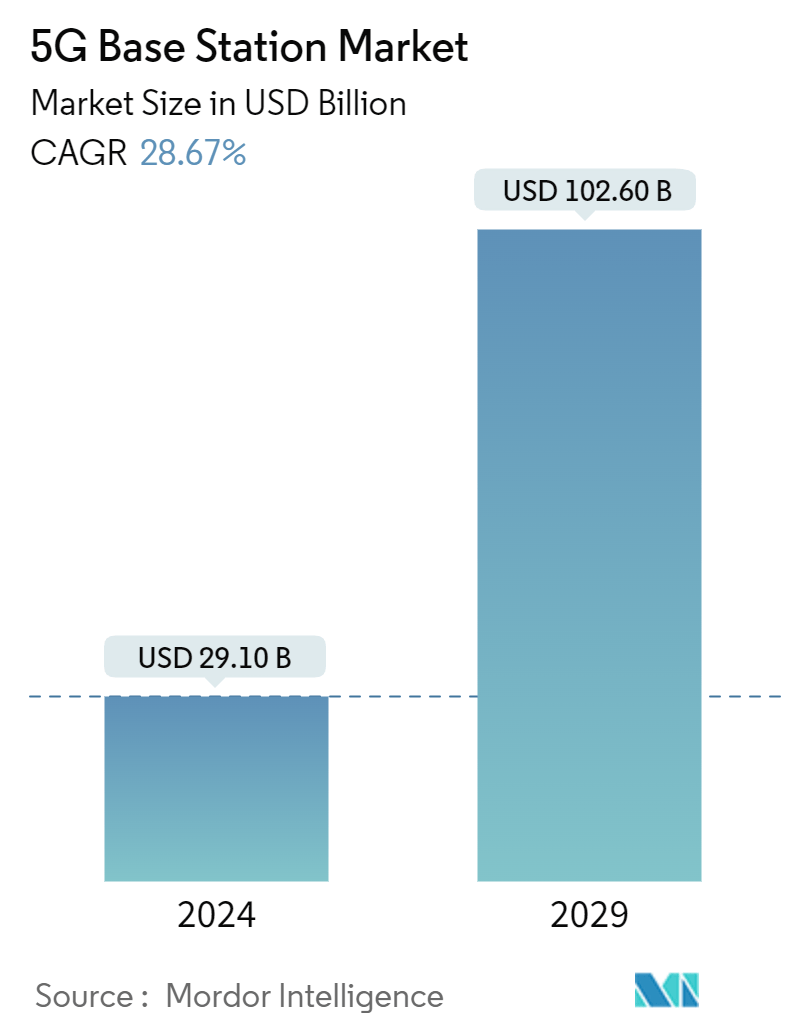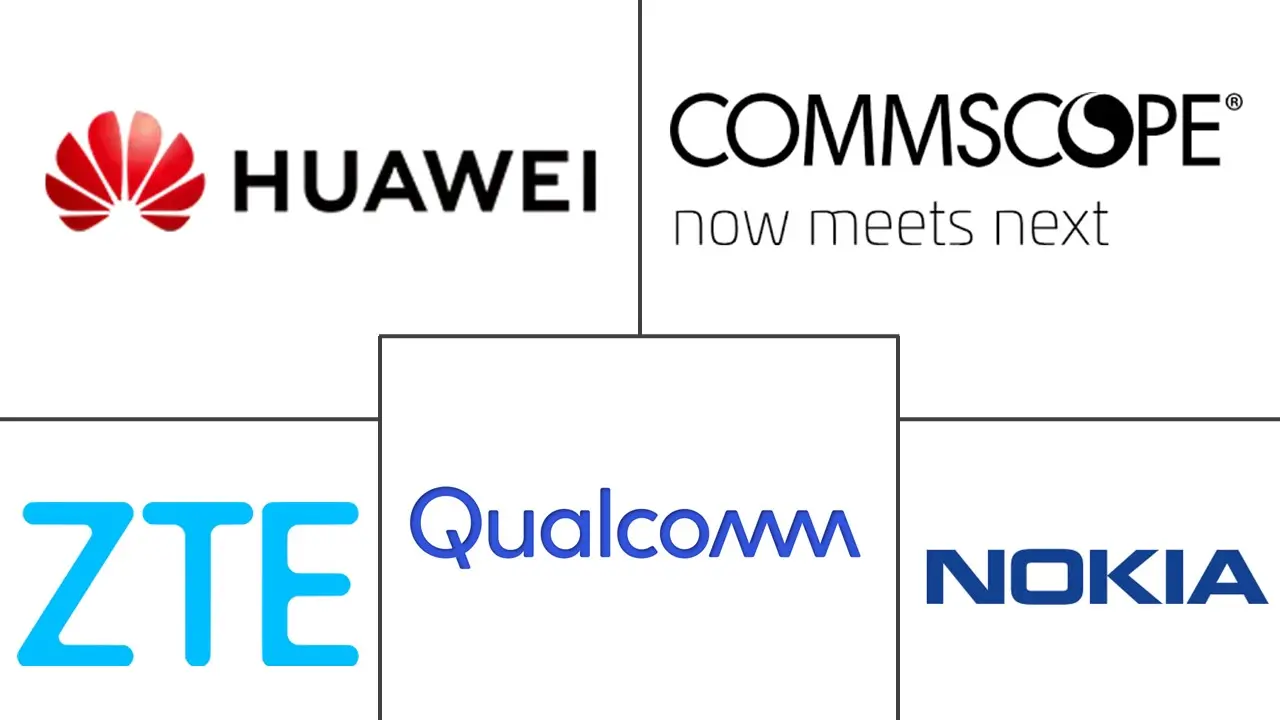Market Size of 5G Base Station Industry

| Study Period | 2019 - 2029 |
| Market Size (2024) | USD 29.10 Billion |
| Market Size (2029) | USD 102.60 Billion |
| CAGR (2024 - 2029) | 28.67 % |
| Fastest Growing Market | Middle East and Africa |
| Largest Market | Asia Pacific |
| Market Concentration | Low |
Major Players
*Disclaimer: Major Players sorted in no particular order |
5G Base Station Market Analysis
The 5G Base Station Market size is estimated at USD 29.10 billion in 2024, and is expected to reach USD 102.60 billion by 2029, at a CAGR of 28.67% during the forecast period (2024-2029).
The growing smartphone penetration globally and the growing demand for high-speed connectivity are boosting the market growth rate. The market sizing estimates reflect the revenue generated from the base station types that are being used by various end-users across North America, Europe, Asia Pacific, and worldwide across different end users.
- 5G technology significantly reduces latency and delays in information transmission. This reduction enhances user experiences and paves the way for innovative applications.
- Moreover, Ultra-Reliable Low Latency Communications (URLLC), a facet of 5G architecture, efficiently schedules data transfers. URLLC supports advanced services in areas like factory automation, the industrial internet, smart grids, autonomous driving, and robotic surgeries. Consequently, the heightened demand for reduced latency in these applications is propelling the global 5G base station market's growth.
- Smartphones have transformed how individuals access and consume data, from internet browsing and video streaming to mobile app usage and social media engagement. As smartphone adoption has surged, so has data consumption. To keep pace with this rising demand, telecom operators are expanding their network capacity and coverage. This growth often necessitates installing additional base stations to manage the heightened data traffic. As smartphone usage expands, so does the demand for reliable mobile network coverage, driving telecom operators to bolster their infrastructure with more base stations.
- The key benefits of the 5G offered over the predecessors include speed upgrades, low latency, enhanced capacity, increased bandwidth, and availability and coverage. Compared to 4G, the emerging 5G networks are characterized by shorter delays, higher capacity, and increased speed. The impact of these network improvements will be far-reaching.
- 5G base station architecture is designed to provide high-speed, low-latency, and massive connectivity to a wide range of devices. The architecture is more complex and adaptable than past generations of mobile networks. Deploying 5G networks requires significant infrastructure investments, including installing new base stations, small cells, and fiber optic cables. Previous generations of cellular networks, 5G infrastructure deployment involved a denser network architecture due to its reliance on smaller cell sizes and increased network capacity. This densification increases the infrastructure requirements and overall capital expenditure, leading to high initial costs for network operators and service providers.
- The growing number of smartphone subscriptions worldwide and the demand for high-speed connectivity are also contributing to the demand for 5G networks, thereby boosting the 5G base station market. For instance, according to the data from Ericsson, the number of smartphone mobile network subscriptions is expected to reach 7948.92 globally by 2028.
5G Base Station Industry Segmentation
The 5G base station is a fixed communication equipment that connects using a single or several antennas. It includes a wireless receiver and a small-range transceiver with an antenna and analog-to-digital converters to transform radio frequency impulses into digital signals. The 5G base station primarily focuses on high-bandwidth and high-traffic-usage scenarios and real-time communications with high reliability and latency requirements.
The 5G base station market is segmented by type (small cell, macro cell), by end user (commercial, residential, industrial, government, smart cities, and other end users), and geography (Europe, Asia Pacific, Latin America, Middle East and Africa and North America). The market sizes and forecasts are provided in terms of value (USD) for all the above segments.
| By Type | |
| Small Cell | |
| Macro Cell |
| By End User | |
| Commercial | |
| Residential | |
| Industrial | |
| Government | |
| Smart Cities | |
| Other End Users |
| By Geography*** | |
| North America | |
| Europe | |
| Asia | |
| Australia and New Zealand | |
| Latin America | |
| Middle East and Africa |
5G Base Station Market Size Summary
The 5G base station market is poised for substantial growth, driven by the increasing demand for high-speed network connectivity and the proliferation of smartphone ownership in both advanced and emerging economies. The technology's ability to provide lower latency rates enhances user satisfaction and facilitates innovative applications across various sectors. This includes ultra-reliable low latency communications (URLLC) that support advanced services such as factory automation, smart grids, and autonomous driving. The integration of 5G technology in smart cities further propels market expansion, as it enhances public safety and security through efficient data processing from IoT devices. Despite the high costs associated with establishing the necessary infrastructure, the demand for 5G base stations continues to rise, particularly in smart city applications where small cells play a crucial role in providing coverage and capacity.
The Asia-Pacific region is a key driver of growth in the global 5G base station market, supported by robust investments and government initiatives promoting rapid deployment. Countries like China, Japan, and South Korea are at the forefront, with significant adoption of IoT and Industry 4.0 technologies fueling demand for 5G infrastructure. The market is characterized by fragmentation, with major players such as Huawei, ZTE, and Nokia competing for market share. Strategic collaborations, like those between Dell Technologies and Nokia, as well as Ericsson and Telefonica, are enhancing capabilities in private wireless connectivity and cloud RAN evolution, respectively. These developments underscore the market's potential for expansion, as companies leverage partnerships to strengthen their positions and meet the growing demand for 5G base stations globally.
5G Base Station Market Size - Table of Contents
-
1. MARKET INSIGHTS
-
1.1 Market Overview
-
1.2 Industry Attractiveness - Porter's Five Forces Analysis
-
1.2.1 Bargaining Power of Suppliers
-
1.2.2 Bargaining Power of Buyers
-
1.2.3 Threat of New Entrants
-
1.2.4 Intensity of Competitive Rivalry
-
1.2.5 Threat of Substitute Products and Services
-
-
-
2. MARKET SEGMENTATION
-
2.1 By Type
-
2.1.1 Small Cell
-
2.1.2 Macro Cell
-
-
2.2 By End User
-
2.2.1 Commercial
-
2.2.2 Residential
-
2.2.3 Industrial
-
2.2.4 Government
-
2.2.5 Smart Cities
-
2.2.6 Other End Users
-
-
2.3 By Geography***
-
2.3.1 North America
-
2.3.2 Europe
-
2.3.3 Asia
-
2.3.4 Australia and New Zealand
-
2.3.5 Latin America
-
2.3.6 Middle East and Africa
-
-
5G Base Station Market Size FAQs
How big is the 5G Base Station Market?
The 5G Base Station Market size is expected to reach USD 29.10 billion in 2024 and grow at a CAGR of 28.67% to reach USD 102.60 billion by 2029.
What is the current 5G Base Station Market size?
In 2024, the 5G Base Station Market size is expected to reach USD 29.10 billion.

